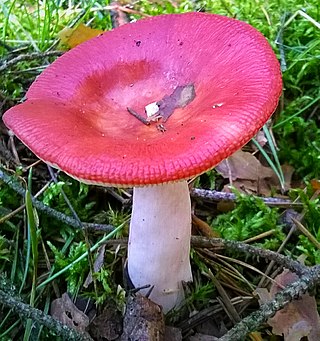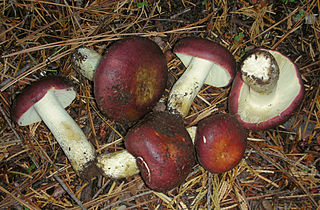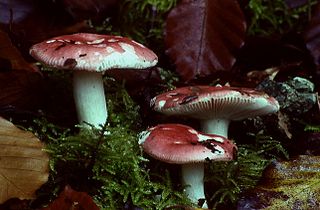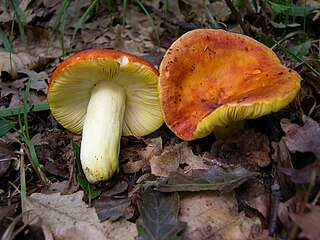
The Russulaceae are a diverse family of fungi in the order Russulales, with roughly 1,900 known species and a worldwide distribution. They comprise the brittlegills and the milk-caps, well-known mushroom-forming fungi that include some edible species. These gilled mushrooms are characterised by the brittle flesh of their fruitbodies.

Lactarius is a genus of mushroom-producing, ectomycorrhizal fungi, containing several edible species. The species of the genus, commonly known as milk-caps, are characterized by the milky fluid ("latex") they exude when cut or damaged. Like the closely related genus Russula, their flesh has a distinctive brittle consistency. It is a large genus with over 500 known species, mainly distributed in the Northern hemisphere. Recently, the genus Lactifluus has been separated from Lactarius based on molecular phylogenetic evidence.

The greater white-toothed shrew is a small insectivorous mammal found in Europe and North Africa. It is the most common of the white-toothed shrews. This species is found along the Mediterranean, Netherlands, Belgium, Ireland, Germany and Portugal; in addition, the Osorio shrew of the Canary island of Gran Canaria, originally described as a separate species, was later discovered to be a population of introduced greater white-toothed shrew. Furthermore, a subspecies of the greater white-toothed shrew, Crocidura russula ibicensis, is found on the Mediterranean island of Ibiza. In April 2008, the greater white-toothed shrew was discovered in Ireland as well. Its preferred habitats are grassland and woodland. It is slightly larger than the lesser white-toothed shrew but otherwise very similar and can often be distinguished only by close inspection of its teeth which are unpigmented.

Russula is a very large genus composed of around 750 worldwide species of ectomycorrhizal mushrooms. They are typically common, fairly large, and brightly colored – making them one of the most recognizable genera among mycologists and mushroom collectors. Their distinguishing characteristics include usually brightly coloured caps, a white to dark yellow spore print, brittle, attached gills, an absence of latex, and absence of partial veil or volva tissue on the stem. Microscopically, the genus is characterised by the amyloid ornamented spores and flesh (trama) composed of spherocysts. Members of the related genus Lactarius have similar characteristics but emit a milky latex when their gills are broken. The genus was described by Christian Hendrik Persoon in 1796.

Russula emetica, commonly known as the sickener, emetic russula, or vomiting russula, is a basidiomycete mushroom, and the type species of the genus Russula. It has a red, convex to flat cap up to 8.5 cm (3.3 in) in diameter, with a cuticle that can be peeled off almost to the centre. The gills are white to pale cream, and closely spaced. A smooth white stem measures up to 10.5 cm (4.1 in) long and 2.4 cm (0.9 in) thick. First described in 1774, the mushroom has a wide distribution in the Northern Hemisphere, where it grows on the ground in damp woodlands in a mycorrhizal association with conifers, especially pine.

Russula xerampelina, also commonly known as the shrimp russula, crab brittlegill, or shrimp mushroom, is a basidiomycete mushroom of the brittlegill genus Russula. Two subspecies are recognised. The fruiting bodies appear in coniferous woodlands in autumn in northern Europe and North America. Their caps are coloured various shades of wine-red, purple to green. Mild tasting and edible, it is one of the most highly regarded brittlegills for the table. It is also notable for smelling of shellfish or crab when fresh.

Russula vesca, known by the common names of bare-toothed Russula or the flirt, is a basidiomycete mushroom of the genus Russula.

Formerly Russula mairei (Singer), and commonly known as the beechwood sickener, the now re-classified fungus Russula nobilis (Velen.) is a basidiomycete mushroom of the genus Russula. This group of mushrooms are noted for their brittle gills and bright colours.

Russula virescens is a basidiomycete mushroom of the genus Russula, and is commonly known as the green-cracking russula, the quilted green russula, or the green brittlegill. It can be recognized by its distinctive pale green cap that measures up to 15 cm (6 in) in diameter, the surface of which is covered with darker green angular patches. It has crowded white gills, and a firm, white stipe that is up to 8 cm (3 in) tall and 4 cm (1.6 in) thick. Considered to be one of the best edible mushrooms of the genus Russula, it is especially popular in Spain and China. With a taste that is described variously as mild, nutty, fruity, or sweet, it is cooked by grilling, frying, sautéeing, or eaten raw. Mushrooms are rich in carbohydrates and proteins, with a low fat content.

Milk-cap is a common name that refers to mushroom-forming fungi of the genera Lactarius, Lactifluus, and Multifurca, all in the family Russulaceae. The common and eponymous feature of their fruitbodies is the latex ("milk") they exude when cut or bruised. Mushrooms with typical milk-cap characteristics are said to have a lactarioid habit. Some of them are edible.
Russula subnigricans, known as the rank russula, or Nise-Kurohatsu (Japanese), meaning "false blackening russula" is a basidiomycete mushroom of the genus Russula found in East Asia.

Russula brevipes is a species of mushroom commonly known as the short-stemmed russula or the stubby brittlegill. It is widespread in North America, and was reported from Pakistan in 2006. The fungus grows in a mycorrhizal association with trees from several genera, including fir, spruce, Douglas-fir, and hemlock. Fruit bodies are white and large, with convex to funnel-shaped caps measuring 7–30 cm (3–12 in) wide set atop a thick stipe up to 8 cm (3 in) long. The gills on the cap underside are closely spaced and sometimes have a faint bluish tint. Spores are roughly spherical, and have a network-like surface dotted with warts.

Russula aurea, commonly known as the gilded brittlegill, is an uncommon species of mushroom found in deciduous woodland in Europe in summer and early autumn. Unlike many red-capped members of the genus, it is edible and mild-tasting.

Russula delica is a mushroom that goes by the common name of milk-white brittlegill, and is a member of the genus Russula, all of which are collectively known as brittlegills. It is mostly white, with ochraceous or brownish cap markings, and a short robust stem. It is edible, but poor in taste, and grows in coniferous, broadleaved, or mixed woods. It can be confused with other white Russula species and certain white Lactarius species.

Multifurca is a rare genus of ectomycorrhizal fungi in the family Russulaceae. It was described in 2008, after molecular phylogenetic study had shown that it forms a monophyletic lineage within the family, sister to Lactarius. The genus contains six species known from the United States, Mexico, Costa Rica, India, China, Thailand, Australia, and New Caledonia, but so far has not been reported from Europe, Africa, or South America. Four of those species were formerly classified as Russula section Ochricompactae, and Multifurca furcata was originally described as a Lactarius species.
Julius Schäffer was a German mycologist. His contributions include studies on the Agaricales, especially the genus Russula, about which he wrote a monograph in 1933. Later, he revised the genus in the series Die Pilze Mitteleuropas (1926–1967); his notes were published posthumously by his wife Liesel in 1952 with the help of other mycologists. The work was considered the "authoritative treatment of the group for Central Europe". One of the Russula species that was first described in this publication was R. laeta. Schäffer developed a chemical test to help with the identification of Agaricus species. A positive reaction of Schaeffer's test, which uses the reaction of aniline and nitric acid on the surface of the mushroom, is indicated by an orange to red color; it is characteristic of species in the section Flavescentes. The compounds responsible for the reaction were named schaefferal A and B to honor Schäffer.

Russula crustosa, commonly known as the crusty russula, is a species of fungus in the family Russulaceae. It is found in Asia and North America.
Multifurca furcata is a rare mushroom-forming fungus in the genus Multifurca. It was originally described as a Lactarius species in 1918 and was moved to the new genus Multifurca in 2008. With the genus Lactarius it shares the exudation of milk-like latex; however, it is microscopically and molecularly distinct. It has been found very infrequently, with currently known localities in the United States, Mexico, Costa Rica, and China.
Multifurca zonaria is a species of mushroom-forming fungus in the genus Russulaceae. Originally described from Thailand as a Russula species in 2003, it was moved to the newly created genus Multifurca in 2008.














